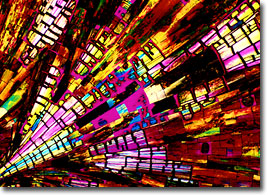|
Crime is a pressing problem in the United States, especially in the juvenile arena. Determining ways to prevent, as well as punish, criminal activity is a matter of great debate. Some, for instance, believe that the threat of a swift, severe punishment acts as a deterrent of criminal acts, while others argue that larger societal changes are necessary to make any significant impact on crime rates. Questions regarding the death penalty, the rehabilitative success of modern prisons, and the responsibility of juveniles for their actions are other central concerns of those involved with the criminal-justice system. Though fully exploring possible answers to these questions is beyond the scope or intent of the crime collection, which places materials frequently involved in the commission of crimes under the microscope, we hope that these photomicrographs will help create an awareness of the current situation.

Surface of a Hunting Knife
The earliest known knives were simple instruments constructed from flint, obsidian, bones, or similar materials. Sharp cutting edges were usually formed by chipping the object or repeatedly rubbing it against a rock, a technique that is still utilized in some cultures today. As early as 1500 BC, knife blades were forged from bronze in China and various other countries. Over time, other metals became the preferred material for cutting instruments, and most modern knives are composed of some form of rustproof steel. A wide variety of knife types has also developed over the course of history, ranging from relatively dull table versions to extremely sharp, heavily serrated hunting knives.

DNA, Fingerprints of the 21st Century
Due to scientific and technological advances, some new types of crime, such as computer hacking and identity theft, have developed into significant concerns. However, similar advancements have also made it easier to identify perpetrators of certain crimes. For instance, in recent years, DNA "fingerprinting" has become a common method used by forensic scientists in the identification of samples of blood and other body fluids. This sophisticated process is based upon the fact that all DNA molecules contain the same set of four nucleotides, but the order in which these occur is unique to individuals. In theory, therefore, DNA could be used to definitively determine whether a sample belongs to a specific person, either implicating or releasing a suspect from guilt in a particular crime. However, the time and cost involved in examining the entire DNA content of an individual, which contains millions of base pairs, makes this approach prohibitive. Instead, DNA fingerprinting typically involves the more practical, though less exact, examination of repeating patterns in DNA, which can only offer a probability, rather than a certain assertion, that a DNA sample came from a certain person, relatives of that person, or a non-related individual.

Mace
Mace is the trade name of a aerosol spray device that contains a form of tear gas known as chloroacetophenone (often referred to as a lachrymatory agent) dissolved a highly volatile solvent. The term "Mace" is often used interchangeably with a newer product, pepper spray, which contains derivatives of the lachrymator, capsaicin. Popular among various law enforcement agencies as well as individual consumers, tear gas or pepper spray can be used for both crowd control and self-defense. The effects of these agents include intense tearing, swelling, and involuntary shutting of the eyes, as well as a burning sensation along the skin, coughing, inflammation, headache, and dizziness. If sprayed directly into the face from close range, permanent injury can occur. Also, individuals that utilize any chemical spray must be careful that the wind will not blow the substance back towards them, resulting in accidental self-incapacitation.

Potassium Nitrate from Gunpowder
Potassium nitrate, which is a white crystalline compound also known as saltpeter, is the chief ingredient of black powder, the first type of gunpowder ever utilized. Many sources credit the invention of this explosive substance to the Chinese, who used it to create fireworks and signals as early as the tenth century, but black powder might also be of Arabic origin. Indeed, it is generally agreed upon that it was the Arabs who first used potassium nitrate-based black powder in a device that could be truly considered a gun. Modern guns bear little resemblance this early bamboo weapon reinforced with steel. In fact, technological improvements in materials used to fabricate guns, along with the development of nitrocellulose and nitroglycerin based gunpowder, have made guns more powerful and precise weapons than ever before.
|




